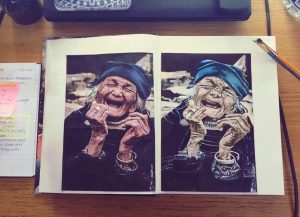Chantal Joffe
By Victoria Miro
I chose to look beyond the cover of this book purely because Chantal Joffe explores portraiture but in a different style to my work and I wanted to research into a more abstract way of presenting outcomes. I was curious.
Chantal Joffe is a contemporary artist and her work shows paintings of woman and children. Her most frequent chosen medium is oil on canvas and she is a very well educated artist; having studied MA Fine Art at the ‘Royal College of Art’ in London and received awards such as the ‘Delfina Studio Trust Award’.
The Book is based around her work produced from 24th June – 2nd August 2008. The ‘appalling’ and ‘witty’ paintings are signifying pornography and fashion, presenting social and sexual signs. Her work is bright and powerful and she expresses emotion in her work by adding paint strokes that are defined and exclude all boundaries.
‘There is art that depicts fashion, there is art that depicts fashionable people, and there is art that is fashionable.’
The above quote was taken from an article produced by Neal Brown. This is presented early in the book before any artwork is shown, so the reader is already thinking ‘fashion’ drawing them to a larger scale of portraiture, rather than just expression and features of the human form. Besides the pornographic imagery, ‘fashion’ is made the main focus behind Joffe’s work and although it is not as detailed as it could be the abstract pieces certainly don’t leave much to the audiences imagination.
Bibliography – birth, education, awards, solo exhibitions and group exhibitions

